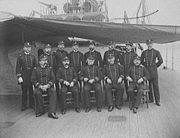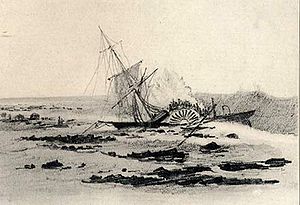
Montgomery Sicard
Encyclopedia

United States Navy
The United States Navy is the naval warfare service branch of the United States Armed Forces and one of the seven uniformed services of the United States. The U.S. Navy is the largest in the world; its battle fleet tonnage is greater than that of the next 13 largest navies combined. The U.S...
during the American Civil War
American Civil War
The American Civil War was a civil war fought in the United States of America. In response to the election of Abraham Lincoln as President of the United States, 11 southern slave states declared their secession from the United States and formed the Confederate States of America ; the other 25...
.
Biography
Born in New YorkNew York
New York is a state in the Northeastern region of the United States. It is the nation's third most populous state. New York is bordered by New Jersey and Pennsylvania to the south, and by Connecticut, Massachusetts and Vermont to the east...
, Sicard was appointed acting-midshipman
Midshipman
A midshipman is an officer cadet, or a commissioned officer of the lowest rank, in the Royal Navy, United States Navy, and many Commonwealth navies. Commonwealth countries which use the rank include Australia, New Zealand, South Africa, India, Pakistan, Singapore, Sri Lanka and Kenya...
on 1 October 1851. After graduation from the Naval Academy
United States Naval Academy
The United States Naval Academy is a four-year coeducational federal service academy located in Annapolis, Maryland, United States...
he was made midshipman
Midshipman
A midshipman is an officer cadet, or a commissioned officer of the lowest rank, in the Royal Navy, United States Navy, and many Commonwealth navies. Commonwealth countries which use the rank include Australia, New Zealand, South Africa, India, Pakistan, Singapore, Sri Lanka and Kenya...
on 9 June 1855. He was then attached to the frigate (1855–6) and steam frigate ) (1856–9) in the Home Squadron
Home Squadron
The Home Squadron was part of the United States Navy in the mid-19th century. Organized as early as 1838, ships were assigned to protect coastal commerce, aid ships in distress, suppress piracy and the slave trade, make coastal surveys, and train ships to relieve others on distant stations...
, and was promoted to passed midshipman
Passed midshipman
A Passed Midshipman, sometimes called as Midshipman, Passed, is an unused and historic term which describes a Midshipman who had passed the Lieutenant exam and was eligible for promotion to Lieutenant as soon as there was a vacancy in that grade....
on 15 April 1858, and to master
Master (naval)
The master, or sailing master, was a historic term for a naval officer trained in and responsible for the navigation of a sailing vessel...
on 4 November 1858.
Receiving his commission as lieutenant
Lieutenant
A lieutenant is a junior commissioned officer in many nations' armed forces. Typically, the rank of lieutenant in naval usage, while still a junior officer rank, is senior to the army rank...
on 31 May 1860, he served aboard the steam sloop in 1861, and on the steam sloop of the West Gulf Blockading Squadron in 1862-3, participating in the capture of New Orleans, Louisiana
Louisiana
Louisiana is a state located in the southern region of the United States of America. Its capital is Baton Rouge and largest city is New Orleans. Louisiana is the only state in the U.S. with political subdivisions termed parishes, which are local governments equivalent to counties...
, late in April 1862; seeing action in the bombardment and passage of Forts Jackson and St. Philip
Battle of Forts Jackson and St. Philip
The Battle of Forts Jackson and St. Philip was the decisive battle for possession of New Orleans in the American Civil War. The two Confederate forts on the Mississippi River south of the city were attacked by a Union Navy fleet...
, at the Chalmetto batteries, and in the destruction of rebel flotilla and transports on 24 April 1862, and in the passage of the Vicksburg
Vicksburg, Mississippi
Vicksburg is a city in Warren County, Mississippi, United States. It is the only city in Warren County. It is located northwest of New Orleans on the Mississippi and Yazoo rivers, and due west of Jackson, the state capital. In 1900, 14,834 people lived in Vicksburg; in 1910, 20,814; in 1920,...
batteries in June. He was present when the Confederate ram made an attack on the Union Fleet on 15 July 1862, receiving his commission as lieutenant commander
Lieutenant commander (United States)
Lieutenant commander is a mid-ranking officer rank in the United States Navy, the United States Coast Guard, the United States Public Health Service Commissioned Corps, and the National Oceanic and Atmospheric Administration Commissioned Corps, with the pay grade of O-4 and NATO rank code OF-3...
the next day. Sicard commanded the during the two assaults on Fort Fisher
Battle of Fort Fisher
Two battles were fought over Fort Fisher during the American Civil War. The first battle was a failed attempt by the Union army and Navy to capture the fort. The second battle was a successful operation which led to the fall of the fort and the city of Wilmington, North Carolina.* First Battle of...
in December 1864 and January 1865, and saw further action at the bombardment of Fort Anderson
Battle of Wilmington
The Battle of Wilmington was fought February 11 – February 22, 1865, during the American Civil War. It was a direct result of the Union victory at the Second Battle of Fort Fisher.-Background:...
on 11 February 1865. Sicard then served aboard the steam sloop on the South Atlantic Blockading Squadron until the war's end.

North Atlantic Squadron
The North Atlantic Squadron was a section of the United States Navy operating in the North Atlantic. It was renamed as the North Atlantic Fleet in 1902. In 1905 the European and South Atlantic Squadrons were abolished and absorbed into the North Atlantic Fleet. On Jan...
in 1868-9. He then took command of the steamer in the Pacific Squadron
Pacific Squadron
The Pacific Squadron was part of the United States Navy squadron stationed in the Pacific Ocean in the 19th and early 20th centuries. Initially with no United States ports in the Pacific, they operated out of storeships which provided naval supplies and purchased food and obtained water from local...
, and was promoted to commander
Commander (United States)
In the United States, commander is a military rank that is also sometimes used as a military title, depending on the branch of service. It is also used as a rank or title in some organizations outside of the military, particularly in police and law enforcement.-Naval rank:In the United States...
on 2 March 1870. On 30 October 1870 the Saginaw was wrecked after running aground on Kure Atoll
Kure Atoll
Kure Atoll or Ocean Island is an atoll in the Pacific Ocean beyond Midway Atoll in the Northwestern Hawaiian Islands at . The only land of significant size is called Green Island and is habitat for hundreds of thousands of seabirds...
. The shipwrecked sailors salvaged supplies from the ship, and five men, led by Lieutenant John G. Talbot
John G. Talbot
John Gunnell Talbot was an officer in the United States Navy.Born at Danville, Kentucky, Talbot was appointed a midshipman in 1862 and graduated from the United States Naval Academy on 12 June 1866. Commissioned ensign on 12 March 1868, Talbot attained the rank of master on 26 March 1869 and of...
, set out in a small boat for the Hawaiian Islands some 1500 miles (2,414 km) away. Arriving at Kauai
Kauai
Kauai or Kauai, known as Tauai in the ancient Kaua'i dialect, is geologically the oldest of the main Hawaiian Islands. With an area of , it is the fourth largest of the main islands in the Hawaiian archipelago, and the 21st largest island in the United States. Known also as the "Garden Isle",...
after 31 days, the boat overturned in the breakers, and only Coxswain William Halford
William Halford
William Halford was a sailor, and later an officer, in the United States Navy. He also received the Medal of Honor.-Biography:...
survived. King Kamehameha V
Kamehameha V
aloghaKamehameha V , born as Lot Kapuāiwa, reigned as monarch of the Kingdom of Hawaii from 1863 to 1872. His motto was "Onipa`a": immovable, firm, steadfast or determined; he worked diligently for his people and kingdom and was described as the last great traditional chief...
sent his steamer Kilauea to rescue the stranded sailors, all of whom survived.
Command duty afloat then alternated with ordnance duty in Washington, D.C.
Washington, D.C.
Washington, D.C., formally the District of Columbia and commonly referred to as Washington, "the District", or simply D.C., is the capital of the United States. On July 16, 1790, the United States Congress approved the creation of a permanent national capital as permitted by the U.S. Constitution....
and New York City
New York City
New York is the most populous city in the United States and the center of the New York Metropolitan Area, one of the most populous metropolitan areas in the world. New York exerts a significant impact upon global commerce, finance, media, art, fashion, research, technology, education, and...
. Sicard was promoted to the rank of captain
Captain (naval)
Captain is the name most often given in English-speaking navies to the rank corresponding to command of the largest ships. The NATO rank code is OF-5, equivalent to an army full colonel....
on 7 August 1881, and served as Chief of the Bureau of Ordnance
Bureau of Ordnance
The Bureau of Ordnance was the U.S. Navy's organization responsible for the procurement, storage, and deployment of all naval ordnance, between the years 1862 and 1959.-History:...
from 1881 to 1890. He was promoted to commodore on 10 July 1894, to rear admiral
Rear admiral (United States)
Rear admiral is a naval commissioned officer rank above that of a commodore and captain, and below that of a vice admiral. The uniformed services of the United States are unique in having two grades of rear admirals.- Rear admiral :...
on 6 April 1897, taking command of the North Atlantic Squadron
North Atlantic Squadron
The North Atlantic Squadron was a section of the United States Navy operating in the North Atlantic. It was renamed as the North Atlantic Fleet in 1902. In 1905 the European and South Atlantic Squadrons were abolished and absorbed into the North Atlantic Fleet. On Jan...
. He was forced to relinquish his command at the outbreak of the Spanish–American War due to ill health. Upon his partial recovery, he was placed in charge of the Board of Strategy and took an important part in guiding the conduct of the war.
Rear Admiral Sicard retired on 30 September 1898, and died at Westernville, New York
Westernville, New York
Westernville, New York is a hamlet located west of Adirondack Park and north of Utica.-History:The Town of Western was formed from the Town of Steuben on March 10, 1797. Its 40,000 acres contain fertile soil and an abundant supply of water, including the Mohawk River, Lansing Kill, Big Brook,...
, on 14 September 1900.
Namesake
The destroyer (1920–1945) was named for him. The Washington Navy Yard in Washington, D.C.Washington, D.C.
Washington, D.C., formally the District of Columbia and commonly referred to as Washington, "the District", or simply D.C., is the capital of the United States. On July 16, 1790, the United States Congress approved the creation of a permanent national capital as permitted by the U.S. Constitution....
also has Sicard Street which is named for him.

